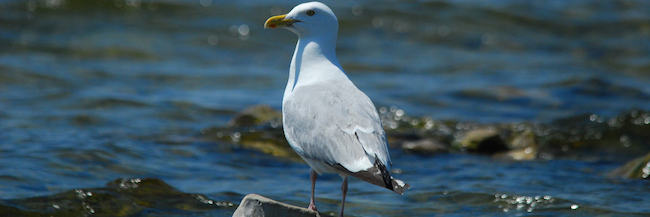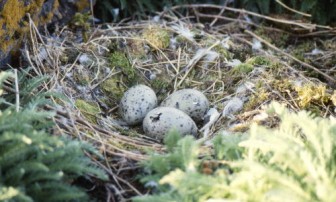
Herring gull. Image: Flickr, Joshua Mayer
By Brian Bienkowski
Environmental Health News
Stain repellent and fire retardant chemicals that scientists know little about are increasingly showing up in herring gull eggs around the Great Lakes, spurring concern for potential health impacts.
The gulls are considered a sentinel species, and the contaminants appearing in their eggs paint a picture of a shifting chemical profile in the Great Lakes, which holds about 20 percent of the world’s fresh surface water. While legacy pollutants, such as mercury and polychlorinated biphenyls (PCBs), still persist, a growing list of esoteric pollutants is showing up in wildlife.
“With phase-outs of some past problem chemicals … we’re now monitoring for and seeing new chemicals that may pose some of the same problems–being persistent, bioaccumulative and toxic,” said Michael Murray, a staff scientist at the National Wildlife Federation’s Great Lakes Regional Center.
Canadian and U.S. researchers studying herring gull eggs found a suite of different flame retardants and perfluorinated chemicals–mostly used as adhesives, stain repellents and lubricants–in samples collected in 2012 and 2013 across the Great Lakes basin.
The chemicals are “emerging” contaminants, so science on their effects is sparse and it’s not completely clear what they might do to the health of birds. Scientists have linked some flame retardants and perfluorinated compounds to reproductive, development and behavioral problems in birds, but the research is limited and simply doesn’t exist for some of the compounds measured in gull eggs in the recent studies.
The “first step is finding them [the compounds] and then finding out if we need to start being concerned,” said Lisa Williams, a contaminants specialist with the U.S. Fish and Wildlife Service based in East Lansing, Michigan, who took part in the research.
As a “sentinel species,” the herring gull’s contaminant load is an indicator of the types of chemicals in other species that inhabit the same area, such as fish and bald eagles, Williams said.
For the flame retardants, which are chemicals added to products such as furniture, electronics and clothing to slow the spread of flames if they catch fire, Williams and colleagues tested hundreds of eggs and found 35 of the 53 compounds they tested for in at least one of the eggs.
There was some good news: Levels of seven polybrominated diphenyl ether (PBDE) flame retardants were about 30 percent lower than concentrations measured in eggs from colonies in 2006.
But three compounds–BDE-209, hexabromocyclododecane and dechlorane–increased significantly compared to eggs tested in Canadian colonies about six years before, suggesting that their use might be on the rise as PBDEs are phased out.
For the perfluorinated compounds they found six of the compounds they tested for in more than 97 percent of the 114 eggs sampled, including new compounds with a slightly different structure than the types commonly found in the past. The study was the first ever to report a perfluorinated compound used as an aircraft lubricant in a bird species. It had only been previously found in aquatic life.
The research on perfluorinated compounds was published in August in the journal Science of the Total Environment. The flame retardant research was published in the journal Environmental Research in September.
Such chemicals travel on air currents so the findings don’t necessarily mean there are local releases to the environment. “Weather patterns bring them to cooler climates, they come out in rainfall and then often are not re-released,” Williams said.

Herring gull eggs. Image: Flickr, Darrick
Since baby birds are exposed to contaminants present in the egg, the findings represent a “direct measure of exposure to developing bird embryos,” Williams said. “It’s often the most sensitive life stage.”
“It’s yet another piece of evidence of the failure of our chemical regulatory system,” said Olga Lyandres, a research manager with Alliance for the Great Lakes, a nonprofit organization focused on restoration of the Great Lakes.
Lyandres was referring to the federal Toxic Control Substances Act, a law that regulates chemicals and the introduction of new ones. Many fault the law for not requiring robust testing of chemicals before they’re widely used.
Lyandres said that some of these newer Great Lakes contaminants are on the radar of regional leaders. One of the goals of the Great Lakes Water Quality Agreement, a commitment between the U.S. and Canada to protect the Great Lakes, is to identify, prioritize and take action on problematic chemicals.
Both perfluorinated compounds and various flame retardants were on the most recent assessment as chemicals that require action. This could mean possibly dredging heavily contaminated areas, or finding industries contributing the chemical loads and stopping the release into the environment, Lyandres said.
For the time being, scientists have to continue playing catch up, Murray said.
“We’re talking about thousands of chemicals potentially out there,” he said. “We have clear limitations in our federal law in terms of what’s required, and there are a whole lot of chemicals out there for which we have so little data.”
This piece first appeared on Environmental Health News and is reprinted with permission. Brian Bienkowski is a former reporter for Great Lakes Echo.